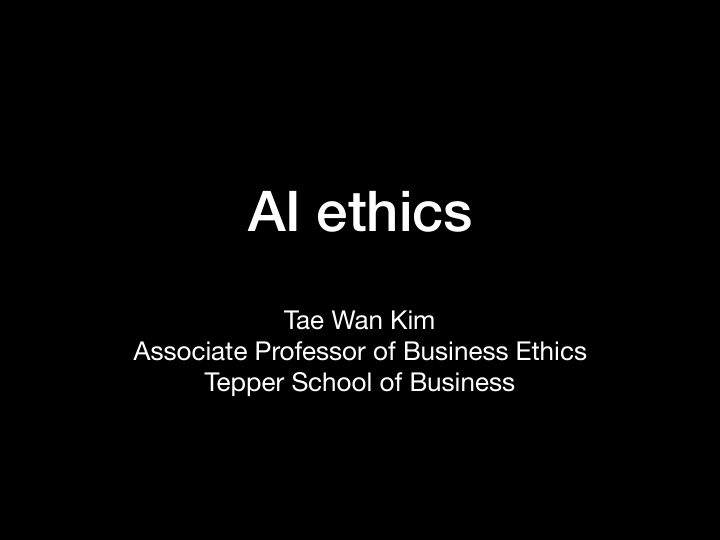



AI ethics Tae Wan Kim Associate Professor of Business Ethics Tepper School of Business
1. Coexistence?
The future trolley problem • Sentience (Utilitarianism): The capacity for phenomenal experience or quaila, such as the capacity to feel pain and su ff er. • Sapience (Deontology): A set of capacities associated with higher intelligence, such as self-awareness and being a reason-responsible agent.
Cat Dog Lion
Sad n i n g T r a i Happy d a t a Shame
Neurons Artifical Neural Networks
The future trolley problem • Sentience (Utilitarianism): The capacity for phenomenal experience or quaila, such as the capacity to feel pain and su ff er. • Sapience (Deontology): A set of capacities associated with higher intelligence, such as self-awareness and being a reason-responsible agent.
2. AI as scapegoat
Consider the following scenario: You are a person from a racially underrepresented group, say, X, and you recently applied to an online mortgage approval system and were rejected. The bank that hosts the online application system has recently started using AI to recommend mortgage applications for approval. You happened to know that the bank’s approval rate for clients of the same race as yours has recently abnormally decreased, for no good reason. You meet with a representative of the bank and claim that the bank has racially discriminated against you, and that the bank should be held liable for the discrimination. The bank representative says that it is impossible for the autonomous artificial agent to discriminate racially against applicants, because the algorithms it uses were designed to be indi ff erent to the race of applicants. To prove that, in front of you the representative submits ten fake applications equally qualified as yours (as judged by independent human evaluators) that consist of 5 whites and 5 Xs. The AI accepts all white applicants but only 2 Xs. The representative looks puzzled.
The Scapegoat Argument P1) “Agent A is responsible for Act X” means just that X is properly attributable to A in a way that renders A open to moral appraisal for performing X. P2) Agent A is open to moral appraisal for Act X just when X is expressive of A’s reflective or deep self or practical agency. P3) Action X is expressive of Agent A’s self or agency only when X identifies with A’s desires, reasons, attitudes, or commitments that move A to perform X (whereas X is not expressive of A’s self or agency when X does not identify A’s desires, reasons, attitudes, or commitments, especially when A does not have volition or control over doing X or A cannot be aware of X). P4) In the mortgage bank case, the racial discrimination was not expressive of any humans’ desires, reasons, attitudes, or commitments, and none of the humans’ practical identities moved the thinking machine to racially discriminate. (The humans did not have volition or control over the autonomous artificial mortgage appraiser’s creating the emergent property of racial discrimination and the humans in the bank were not able to be aware of the autonomous machine’s discriminative appraisal) C) Thus, the humans in the bank are not responsible for the outcome action.
Principle of Fair Reciprocity • If accidental or unforeseeable harm is an inevitable externality of freedom of action, a just society should implement a reasonable principle to fairly allocate the cost of unforeseeable harms. • In a liberal society in which equal and free persons, who have di ff erent conceptions of good, live together, reciprocity is one of the few agreed upon principles. Reciprocity here means that burdens must be borne by benefits. • The cost of unforeseeable harms created by a company that uses AI must be proportionately aligned with the benefit that companies and other parties gain by using AI. • One e ffi cient way to require companies that use AI to take the proportionate responsibility to remedy unforeseeable harms. By doing so, the burden is accordingly apportioned across companies and across customers who benefit from the companies’ AI services.
3. Super-intelligence and “Existential risk”
From HLAI to Superintelligence
The good-story bias • “Our intuitions about which future scenarios are plausible and realistic are shaped by what we see on TV and in movies and what we read in novels…..We should then suspect our intuitions of being biased in the direction of overestimating the probability of those scenarios that make for a good story, since such scenarios will see much more familiar and more real.” Nick Bostrom
Recommend
More recommend